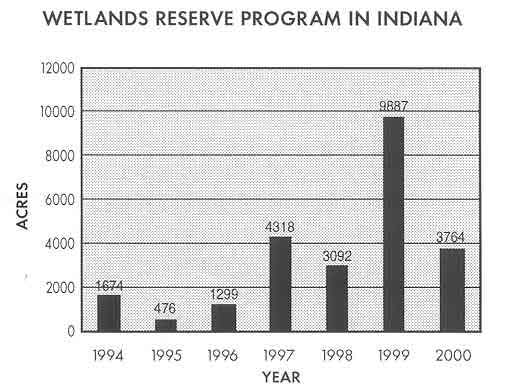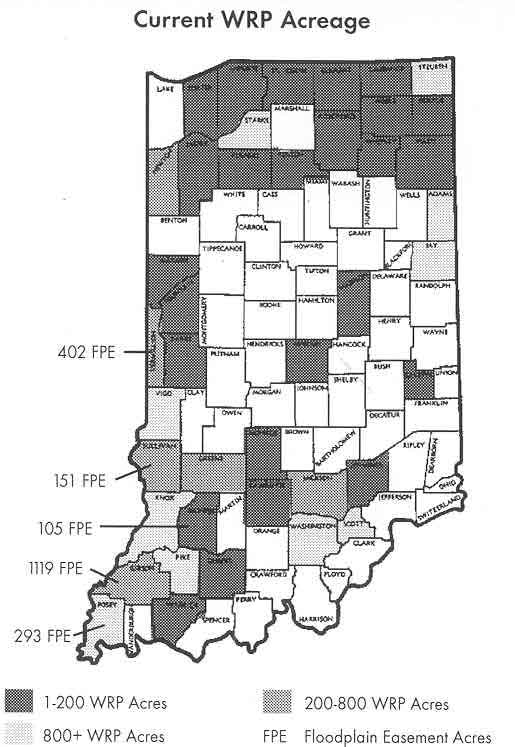
Summer 2000, Volume 9, Number 2
Wetlands Reserve Program in Indiana
Many landowners in Indiana have opted to participate in the United States Department of
Agriculture Wetlands Reserve Program (WRP). This program allows for voluntary
participation by landowners to restore and protect wetland areas. The WRP program allows
the landowner to receive payments for marginal land that has been put into permanent or 30
year easements as wetland areas. The Wetlands Reserve Program was authorized by the Food
Security Act of 1985 (and as amended in the 1990 and 1995 Farm Bills). In addition to
receiving payments for the easements, landowners also receive cost-share funds for wetland
restoration practices, such as tree planting, water control structures, dikes, etc.
Participants in the WRP program retain ownership of the property, and control access to
the site. The land can be sold, however, the wetland easement remains with the land. There
are several advantages to restoring land to wetlands including, (1) improved water
quality, (2) filtering of sediment, (3) increased habitat for wildlife and endangered
species, (4) reduction in soil erosion, (5) flood control, (6) water supply, and (7)
increased opportunity for outdoor recreation and education. The program is offered
nation-wide during a continuous sign-up. Interested landowners sign-up with their local
Natural Resources Conservation Service (NRCS) Office. Certain eligibility requirements
must be met to qualify for the program.
Basic eligibility requires that a landowner must have clear title to the land and have
owned the land for 12 months before the end of the sign-up period. Land eligible for
inclusion in WRP must have the potential to contribute to the functions and values of
wetland ecosystems. In Indiana, the following types of lands are eligible, land that has
been hydrologically modified (filled, ditched, tiled or pumped)and formed-such as those
lands identified by NRCS as, (I ) formed wetlands, (2) prior converted cropland, (3)
farmed wetland pasture, and (4) lands substantially altered by flooding. Adjacent lands
that contribute significantly to the functions and values of an easement area are eligible
as long as it is less than 50 percent of the area. This would include upland buffer area
and non-cropped wet-land areas. Wetlands restored under a state or federal program are
eligible. Riparian areas that link two or more wetlands that are protected by an easement
or similar agreement are eligible if the area averages no more than 150 feet in width on
each side of the stream and up to one mile in length. Applications are taken continuously.
The applications are then ranked based on criteria set forth by the Indiana State
Technical Committee.
The first sign-up in Indiana was in 1994 with subsequent sign-up since 1995, 1996, 1997, 1998, 1999, and 2000. The interest in the WRP program has for exceeded the available finding. As of January 2000, NRCS has received approximately $27 million dollars, which has allowed the funding, of 200 applications for a total of 24,500 acres in WRP. The funding includes the cost of appraisals, surveys, title work, wetland restoration and easement costs. Forty-four counties have received WRP funds. The highest area of concentration of funded WRP applications are found in the Muscatatuck/White River Basin in south central Indiana, the Patoka/White/Wabash River Basins in southwestern Indiana, the Kankakee River Basin and the northeastern portion of the state. As interest continues in the WRP program and wetlands in general, NRCS hopes to be able tc@ fund more applications. The Fiscal Year 2000 funding for WRP is anticipated to be the largest thus for landowners enrolling in Fiscal Year 2000 (October 1999 to September 2000) should have their best opportunity to get into the program.
If you are interested in the Wetlands Reserve Program, please contact the local County Soil and Water Conservation District or Gerald Roach, Wetlands Reserve Program Coordinator at (812)752-2269, ext. 113.
Frequently Asked Questions
How can I get involved in WRP?
Check with your local USDA Service Center or Conservation District to sign up. NRCS, with input from FWS and State wildlife agencies, will determine if the acres you offer are eligible for the program. Landowners with high priority acres - based on competitive selection - will receive an offer.
How much will I get for my land?
The program offers landowners three options: permanent easements, 30-year easements, and restoration cost-share agreements of a minimum 10-year duration.
Permanent Easement. This is a conservation easement in perpetuity. Easement payment will be the lesser of: the agricultural value of the land, an established payment cap, or an amount offered by the landowner,. In addition to paying for the easement, USDA pays 100 percent of the costs of restoring the wetland. The maximum payment cap for Indiana is $1,000 on permanent easements.
30-Year Easement. This is a conservation easement lasting 30 years. Easement payments are 75 percent of what would be paid for a permanent easement. USDA also pays 75 percent of restoration costs. The maximum payment cap for 30-year easements is $750.00
Restoration Cost-Share Agreement. This is an agreement (generally for a minimum of 10 years in duration) to re-establish degraded or lost wetland habitat. USDA pays 75 percent of the cost of the restoration activity. This does not place an easement on the property. The landowner provides the restoration site without reimbursement.
What can I do with my land once it is in WRP?
The plan you developed with NRCS identifies the activities necessary to restore, enhance, protect, maintain, and manage the wetland. The restoration plan is dynamic and will change over the years as resource needs are evaluated. You continue to control access to the land - and may lease the land - for hunting, fishing, and other undeveloped recreational activities. At any time, a landowner may request that additional activities be evaluated to determine if they are compatible uses for the site. Compatible uses are allowed if they are fully consistent with the protection and enhancement of the wetland.
How much land will I be able to enroll?
Once your eligibility has been determined, we will discuss with you the eligible wetland and surrounding area necessary to restore and sustain the ecosystem. Ideally a mix of wetland and upland acres is desired to meet the needs of the wildlife community and other objectives such as water quality, flood reduction, and groundwater recharge. Up to a 1: 1 ratio of eligible land to other land can be enrolled.
Do I need to hire, a closing agent, appraiser, surveyor, or lawyer?
Before an easement is recorded, NRCS will arrange for closing services to conduct title searches, acquire title insurance, and perform any other activities necessary to clear the title and complete the easement. The landowner will hire the surveyor and be reimbursed for surveying costs.
Will I still have to pay taxes on the easement area?
Yes. The amount of taxes you pay on the easement area is determined by the local taxing authority. Landowners should seek this information before entering the WRP.
What can I do about reducing the local property tax when I enroll land in WRP?
This is a local or State decision and NRCS has no authority regarding property or other tax issues. However, we can provide written documentation of the easement to help the landowner discuss this issue with a tax consultant.
Are there minimum and maximum acreage requirements?
Permanent and 30-year easements have a five acre minimum size. Restoration cost-share agreements have a one-acre minimum size. There is no maximum acreage cap.
What type(s) of practices will be installed on my land?
The program is a wetland program, therefore, the emphasis will be to try and restore as much of the original hydrology as possible. Practices such as tile cuts, ditch plugs, low level dikes and macro-topography (shallow excavation)can be used. Vegetative practices include tree planting, warm season and cool season grass plantings. Vegetative practices are done to maximize wildlife benefits.
Can I sell my property after it is enrolled in WRP?
Yes, property can be sold. The easement does stay with theproperty.
Can timber harvest be done on WRP?
Requests for timber harvest have to be authorized by theState Conservationist using the compatible use process.
Can ponds be developed on WRP easements?
Program emphasis is on developing wetland habitat for migratory waterfowl. Wetland habitat would typically be areas having saturated soil up to 2-3 feet of shallow water. Ponds are not developed in the WRP Program.
What are my chances of getting funded for WRP?
WRP is under a continuous sign up. Applications are taken and the sites are reviewed by NRCS and USFWS personnel. A variety of factors are evaluated. Those sites with the highest ranking are funded. Indiana has typically received 3 to 5 million dollars per year to fund applications. This funding allows NRCS to fund approximately 30% of eligible applications. Unfunded applications are retained in a database and funded as applicants cancel or additional funds become available.
How can I find out more about WRP?
Additional information on WRP is available from USDA Service Centers, State Cooperative Extension offices, and local Conservation Districts. Information is also available on USDA's World Wide Web site: http://www.nrcs.usda.gov. Indiana has a success story listed on this web site. Additional questions can be directed to Gerald Roach, WRP Coordinator, phone number(812) 752-2269, ext. 3, or e-mail address is jerry.roach@in.usda.gov